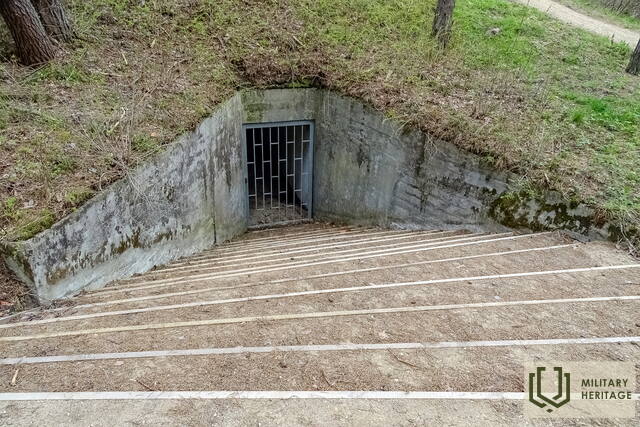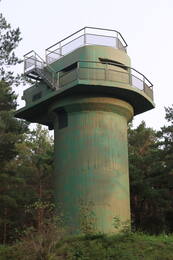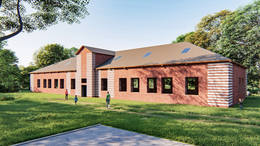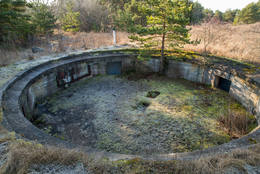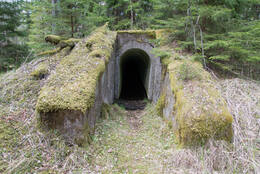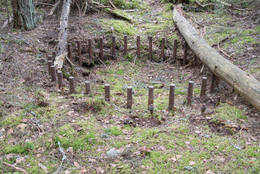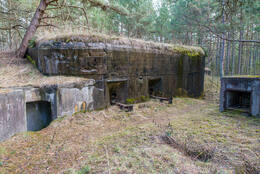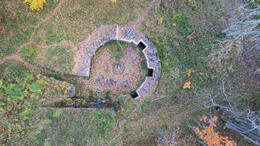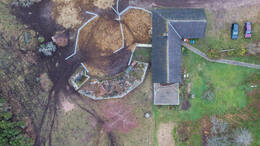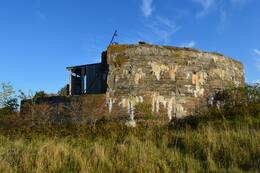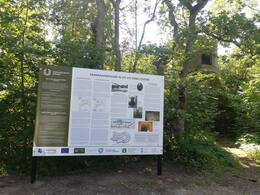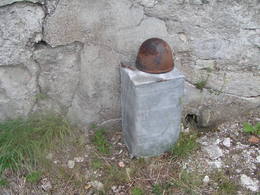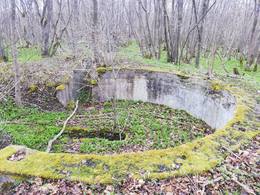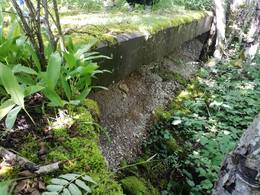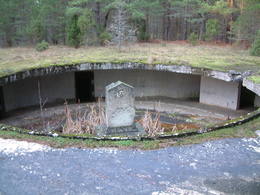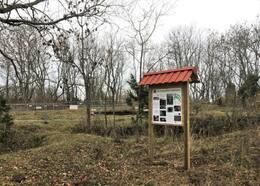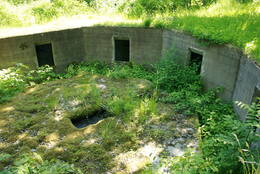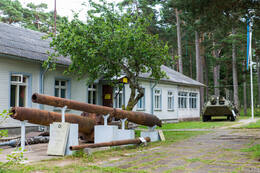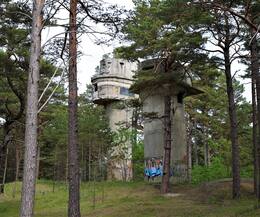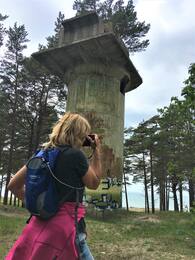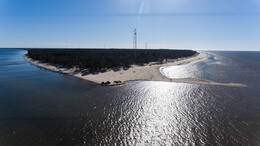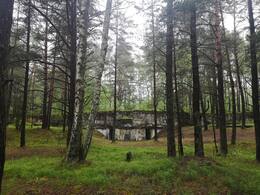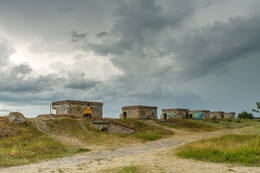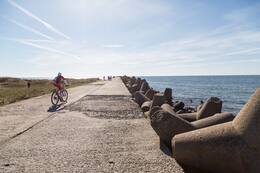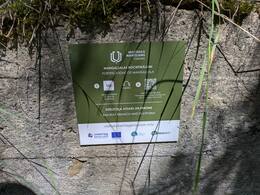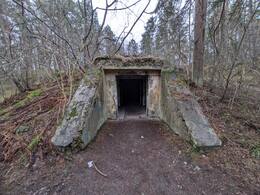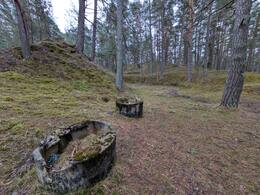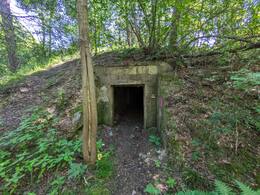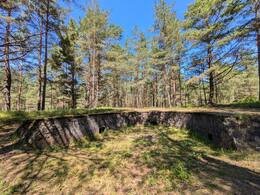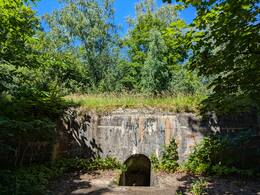Coastal defence battery
I World War I, II World War II, IV Soviet Occupation
Seashore fortification designed to repel naval attacks.
More information sources
Coastal defense batteries (diggers.lv)
Related objects
Fire correction tower of the Ventspils 46th Coastal Defence Battery
The restored fire control tower of the 46th Coast Guard Battery in Ventspils is located on Saulrieta street and is available to visitors in the form of an observation tower. There are four artillery gun positions near the tower and it is the only World War II coastal defence battery in Latvia in such a good condition. Visitors can take the tower stairs to an outdoor viewing platform overlooking the sea. An information stand with a QR code is available next to the tower. You can use the QR to watch an animation about historical events. There is a new street leading to the tower, a large parking lot and a wooden footbridge that crosses the protected nature area next to the tower.
This military complex was built in 1939, marking the start of construction of USSR military bases in Latvia. The 46th Coast Guard Battery had four positions for the gun type Б-13. This battery had its first military engagement on 24 June 1941, when Ventspils harbour was attacked by German torpedo boats that were driven away from the shores of the Baltic Sea by battery fire. On June 28 the Soviet Army blew up the guns and left.
Olman Battery No.456 (Soviet military base "Krasnoflotska")
The first coastal defence batteries for the defence of the Irbe Strait were built after 1912, when the Baltic Fleet Mine-Artillery Defence Position Plan was approved, which included several coastal defence batteries and sea mine-laying.
The Irbe Strait position was the furthest south, and its task was to block any enemy access to the Gulf of Riga. The main emphasis was on sea mines, tens of thousands of which were laid in the Irbe Strait during WWI by ships of the Baltic Fleet. It was not until 1916 that coastal defence batteries began to be built on the southern tip of the island of Saaremaa, Cape Sorve. Seven batteries were built in total, and Battery 43 was equipped with 305 mm guns. No defence batteries were built on the Latvian coast of the Irbe Strait.
Even after the establishment of the Republic of Latvia, the Latvian army and navy did not establish artillery positions to defend the Irbe Strait.
The situation changed after the mutual assistance pact between the Republic of Latvia and the USSR of 5 October 1939, which provided for a contingent of the Red Army and the Baltic Naval Fleet to be stationed in Kurzeme. Soviet plans also included the establishment of a coastal defence system based on the 1912 plan, with improvements. The plan was to build coastal defence batteries on the site of the Liepaja fortress, with new batteries south of Ventspils (Battery No 46) and two batteries in the narrowest part of the Irbe Strait near Mikeltornis. Already after the occupation and annexation of Latvia, the coastal defence plans of the Baltic Navy were supplemented and by June 1941 the 207th Artillery Division with five batteries was planned to be established in the northern part of Kurzeme. Two batteries were to be set up in the vicinity of Mikeltornis - Battery 40 at Lūžņa with 130 mm B-13 guns in reinforced concrete fortifications, and Battery 117 at Olmani (a place designated on Latvian army maps as Ķesteri) with 152 mm MU-2 guns. As the development of the 152 mm guns was not completed, temporary wooden platforms were built on the reinforced concrete fortifications of the battery and four more 130 mm guns were installed. Both batteries were completed by June 1941, but the batteries could not be traced in the war against the German 291st Infantry Division, and their crews moved to the island of Saaremaa.
At the end of WWII, the German Army Group "Courland" was quite serious about possible Soviet landings in northern Courland, especially after the ice melted in the Gulf of Finland and on the west coast of Estonia. Improvised coastal defence batteries were deployed all along the Kurzeme coast. The Soviet Battery No 40, Gerate Batterie Sommer of the 289th Artillery Division with two 122 mm Soviet howitzers, was stationed in reinforced concrete positions near Luzhne. In the area of Battery 117's position was Battery 2 of the 530th Artillery Division with three 152 mm Soviet trophy guns, three 37 mm zenith drones, one 20 mm four-barrel zenith drones, two 75 mm anti-tank guns and two mortars for illumination.
After the end of active hostilities in May 1945, the USSR began to rebuild the coastal defence system on the Kurzeme coast. In the autumn of 1945, a temporary Battery 456 with 152 mm guns of the Kane system was deployed near the Olmaņi farm, which was renamed "Krasnoflotskaya".
In 1952, the temporary guns of the battery were replaced by the latest 152 mm MU-2 weapon systems. The battery consisted of four reinforced concrete gun emplacements, a reinforced concrete command post with a range-finder turret and technical buildings. The construction of the battery was completed in 1958.
In 1958, after the dismantling of the Lūžņa coastal defence battery, it was replaced by a mobile 130 mm SM-4-1 gun Battery No 343. The mobile guns did not have reinforced concrete gun emplacements, but several log and sand structures were built.
Battery 343 operated until the early 1960s, and Battery 456 until 1975, when it was preserved. The battery positions were used to deploy S-125 air defence missile complexes, as well as the 10th Coastal Defence Artillery-Missile Regiment with CP-2 Sopka missile complexes, and the infrastructure was modified accordingly.
The Soviet Army transferred the infrastructure of the Olmaņi and Lūžņa batteries to the Republic of Latvia in 1993.
Ristna coastal battery no.42 and radar station
The area between the Southern Cape of Ristna and Kalana Port in Hiiumaa is tightly packed with military objects. As the structures of different eras and military units are randomly scattered, you can only wonder about the function of several objects. After the battery was closed down in 1960, an early warning radar company moved to the base from North Ristna. In 1986 large-scale work began: a two-storey 16-apartment block for officers remained incompleted, a foundation of barracks was completed and the brick-laying of walls had started. The block of flats is still standing, the barracks have been demolished to their foundations. From 1979 a department of making aluminium spoons operated in Ristna base. It was meant to keep the officers’ wifes busy working but later it was employing some local people as well.
A border guard technical observation post was located in direction of Kalana Port, by now it has been demolished.
The 130mm four-weapon armed battery completed in 1940 was situated half a kilometre South of its present location. You can identify the craters of two gun emplacements, the parapets and bolt circles. Very little is known about the operations of the battery in 1941. Allegedly the crew blew up the guns after running out of ammunition and retreated to Tahkuna.
After the war the battery was opened. In 1945 three 127- mm warship guns of US origin were installed on temporary positions.
The four surviving ferroconcrete gun blocks were constructed in the 1950s. This is the only battery of such design in Hiiumaa. The circular gun emplacement is surrounded by a closed gallery with two long corridors stretching out from it, lined with ammunition depots. The length of a gun block is ca 60 metres and as there are only a couple of metres between the corridor entrances, it was possible to move from one end of the fire position to the other along concrete corridors in a hidden, safe manner. The ferroconcrete fire control tower was completed in 1953 with artillery radars and an optical 6-metre range finder installed in it. The tower is in a better condition than the one in Tahkuna, although a couple of original metal staircases have disappered and have been replaced by temporary wooden ladders. The rest of the buildings of the battery (ammunition depots, power station, machine gun bunkers) are in a relatively good condition and dry, overgrown, though. A remarkable amount of equipment, shelves, ventilation pipelines, original metal doors and shutters of the battery have survived.
The battery was closed down in 1960, after that an early warning radar company moved here from North Ristna resulting in the construction of massive concrete hangars and radar hills. Some of the battery buildings (ammunition depots, a power station) were used by the early warning radar company as well, some reconstruction was done and some entrances were walled in. One gun emplacement was filled with earth. The command post and the sauna also originate from the battery era. A dummy radar had been installed on the Cape of North Ristna. In 1976 a concrete helicopter pad was completed.
The 180-mm Coastal Battery at Tahkuna No 316
Three 180-mm coastal batteries with twin towers were built in Estonia: in Osmussaar, on the Cape of Sõrve Säär in Saaremaa (so-called Stebel Battery) and in Hiiumaa. Tahkuna battery no. 316 comprised two 180-mm twin-gun devices MB-2-180. The distance between gun blocks is 450 m. Due to swampy ground the construction was complicated, the pumps were constantly working. Concrete casting had to be carried out uninterrupted, the casting of one position (ca 6500 m3 ferroconcrete) took five days. The ceiling is 2.7 m thick. The total weight of the gun tower is 375 tons, the armour of the tower is 203 mm. The crew - 55, ammunition reserve – 408 shells and 819 cartridges.
About 500 m North of the guns a two-storey underground control centre with two entrance tunnels (85m and 38m) was built. On the ceiling of the control centre there is an armoured cupola with a visor opening. On the top of the ceiling of the separate shelter, located next to the control centre, there used to be a range finder. The armoured chamber of the range finder was moved away from its original position during the construction of the radar station in 1985. Diesel generators provided an autonomous power supply to the control centre and the gun blocks.
After blow-up in October 1941 the pumps stopped, water diffused into the two-storey blocks and is still there today. The water was pumped off the Tahkuna facing block in 1953. Two diesel units were moved out and they were reassembled as one at Kärdla Power Station and they provided Hiiumaa with electricity from 1956–1967. The top parts of the gun towers (two storeys) were cut into scrap metal at the end of the1950s. The broken barrel that had been buried deep in the ground next to Tahkuna facing block was pulled out in 2003 and is now on show in Hiiumaa Military Museum.
The 6-inch Coastal Battery at Lehtma
The battery, which was completed in 1916, was located 3 km of Lehtma Port in the direction of Tahkuna with four 6-inch Canet’ guns on wooden platforms. The emplacements of three guns are still identifiable – one has a full bolt circle and the two others show some base baulk bolts. The fourth gun together with the entire ammunition of the battery was blown up in 1917 and only a large crater remains. Behind the battery in the woods there are plenty of shelter craters, a well and foundations of buildings. Solid drainage ditches still work. There was a railway connection with Lehtma Port.
The 130-mm Coastal Battery at Tahkuna No 26
The 130-mm battery at Tahkuna is architecturally similar to the battery at Tohvri. The ferroconcrete surfaces in the gun emplacements bear the inscripted date 20/IV 1941. In 1941 the battery had four 130-mm B-13 guns (weight of gun including shield 12.8 tons, crew 11, shooting range up to 25 km). The crew included 151 seamen and 9 officers. The guns were installed right before the battles of October 1941.
The ferroconcrete gun blocks remained intact in the war and the crew arrived as early as October 1944. First the battery had three 130-mm B-13 guns. The last shots were fired in Tahkuna in January 1960 when there were 4 guns. When the battery was operating, the last kilometre of the road leading to the lighthouse was closed by a barrier and a gate house and this part of the road is still missing on the military topograhic map published in 1959.
The buildings of Tahkuna battery have survived in a fairly good state. In the ammunition depots next to the gun blocks occasional shell shelves have survived, they can also be found in the ammunition depots in the rear of the emplacements. The shelter-power station (the gas shelter) still has bunk beds. Between the boiler house and the diesel power station there is a particular water line hidden in a high parapet with a concrete reservoir at both ends. A fire control tower was built next to the command post in the 1950s and after the battery was closed down, it was used as an observation post of the naval radio technology unit. As the forest kept growing and the seaview got worse, the tower gained another floor. This new addition demonstrates a notably poorer building quality in comparison with the rest. The added floor includes a stove, whereas originally the tower had central heating. On the whole territory of the battery there are cable ditches that have been dug open – dating from the 1960s when the collective farms were permitted to take electric gear from the abandoned batteries, as well as from the early 1990s when all the cables that had been meanwhile installed and could be spotted, were taken. With the territory being completely neglected and heavily overgrown, finding and studying the objects could be complicated.
On the territory of the battery, next to the parking lot, there is a monument from 1968 in memory of the Baltic Navy soldiers who perished in 1941. The author of the monument is Vitali Navoznyhh, originally from Leningrad. He participated in the battles of 1941 in Hiiumaa and settled on the island after the war, working as a stonecarver. Next to the monument there is a tombstone to two unknown soldiers who were buried there in 1973.
130-mm Coastal Battery No 44 at Tohvri (Hindu)
A building battalion of the Red Army arrived in Hindu village in October 1939. The local population was ordered to leave their homes before winter. By the following spring the battery area was surrounded by a wire fence. Building material arrived via Sõru Port where work was done in 3 shifts, 24 hours a day. At least a hundred local men were employed to build the battery. Concrete mix was manually made in large tubs, foundation holes were dug. The barracks were going to have two storeys, the second storey angle iron framework was completed when the top committee came to check on the construction. An order was given to demolish the second floor because it was visible from the sea. By the autumn of 1940 two barracks, two officers’ residential buildings, a canteen, two saunas, a food cellar, two firefighting water reservoirs and a gate guard post were completed. A large-scale construction was to continue and there were a couple of thousands of tons of cement in the depots.
The crew of the battery included 5 officers and 125 lower rank soldiers. The test firing of guns took place in summer 1941 when boat-like vessels with masts towed by tugboats on long wire ropes appeared. The battery was never fully completed, some of the shelters and the water reservoir are not covered with earth. The armoured doors were probably never fully installed. Just the concrete floor of the gas shelter (shelter-power station) with its spiky reinforcement iron bars got completed. One gun and its crew were taken to Heltermaa in September 1941. During the German landing in October an ammunition shelter together with the rest of the battery’s ammunition were blown up. The powerful explosion ripped and scattered the walls of the explosive charge room and raised its roof into the air which broke in two after falling on the standing wall.
The other three gun blocks have survived more or less intact and dry. Recently, the area has been cleared and the positions can be fairly easily identified. The command post is half filled with water the whole year round. Due to its wet location the ferroconcrete and bricks are in a notably worse condition than in Tahkuna.
Around the battery there are five machine gun bunkers, each of a different construction. A couple of hundred metres to the Northwest of the battery position there is a small open observation post. There are two machine gun bunkers by the base as well. Near the upper lighthouse of Sõru there are the ruins of a machine gun bunker with a shooting sector of laid bricks. At least 15 such weapon pits were built between Tärkma and Õngu in 1941.
In 1944–1945 the battery was reconstructed with three 130-mm guns. The last training shots were taken on 23.09.1957. The following March the guns were taken away and then the battery was closed down. Today the former base accommodates Tohvri nursing home.
120-mm Battery No 34 at Hindu (Sõru)
The construction of the battery began in 1914. As it was an additional battery, missing in the original plan of the naval fortress and the type of guns was repeatedly changed. Finally four 120- mm Vickers guns were installed. A 200-m length and 10-20-m width sandbar was piled up in defence of the gun emplacements and covered in concrete above the guns. Hindu was the only battery in Hiiumaa that participated in combat operations during the Tagalahe landing on 12 October 1917. After a brief exchange of fire with the German warships the Russian artillerymen fled, leaving the battery intact. The Germans sent a landing unit of soldiers inland that blew up the guns of the battery. One of the German warships that shot Hindu battery, was ’Bayern’, the warship with the largest displacement that has ever been in the Estonian waters (length 180 m, displacement 32 200 tons, eight 380-mm guns).The building of the battery radio station was transported to Emmaste and was used as the community centre (demolished in the 1980s). The gun barrels and other larger details were still there in 1937. Today the first and the second gun platforms are still identifiable, the other two are situated on a fenced farmyard. The third gun crater is filled with earth and there is a newly built house facing the sea, the remains of the fourth one is merely a cracked concrete platform. Out of two air defence gun platforms, one survives (a hundred metres toward the nursing home, on the right side of the road). There are no intact buildings. The machine gun bunker between the first and the second emplacement was completed in 1941.
Concurrently with the construction of Hindu battery, there was a plan to build something in Lepiku village where large gravel bars were piled up, still visible today. It is unknown what the building was going to be.
130-mm Coastal Battery No 44 at Tohvri (Hindu)
A building battalion of the Red Army arrived in Hindu village in October 1939. The local population was ordered to leave their homes before winter. By the following spring the battery area was surrounded by a wire fence. Building material arrived via Sõru Port where work was done in 3 shifts, 24 hours a day. At least a hundred local men were employed to build the battery. Concrete mix was manually made in large tubs, foundation holes were dug. The barracks were going to have two storeys, the second storey angle iron framework was completed when the top committee came to check on the construction. An order was given to demolish the second floor because it was visible from the sea. By the autumn of 1940 two barracks, two officers’ residential buildings, a canteen, two saunas, a food cellar, two firefighting water reservoirs and a gate guard post were completed. A large-scale construction was to continue and there were a couple of thousands of tons of cement in the depots.
The crew of the battery included 5 officers and 125 lower rank soldiers. The test firing of guns took place in summer 1941 when boat-like vessels with masts towed by tugboats on long wire ropes appeared. The battery was never fully completed, some of the shelters and the water reservoir are not covered with earth. The armoured doors were probably never fully installed. Just the concrete floor of the gas shelter (shelter-power station) with its spiky reinforcement iron bars got completed. One gun and its crew were taken to Heltermaa in September 1941. During the German landing in October an ammunition shelter together with the rest of the battery’s ammunition were blown up. The powerful explosion ripped and scattered the walls of the explosive charge room and raised its roof into the air which broke in two after falling on the standing wall.
The other three gun blocks have survived more or less intact and dry. Recently, the area has been cleared and the positions can be fairly easily identified. The command post is half filled with water the whole year round. Due to its wet location the ferroconcrete and bricks are in a notably worse condition than in Tahkuna.
Around the battery there are five machine gun bunkers, each of a different construction. A couple of hundred metres to the Northwest of the battery position there is a small open observation post. There are two machine gun bunkers by the base as well. Near the upper lighthouse of Sõru there are the ruins of a machine gun bunker with a shooting sector of laid bricks. At least 15 such weapon pits were built between Tärkma and Õngu in 1941.
In 1944–1945 the battery was reconstructed with three 130-mm guns. The last training shots were taken on 23.09.1957. The following March the guns were taken away and then the battery was closed down. Today the former base accommodates Tohvri nursing home.
Coastal Battery No 43 at Sõrve Säär
This coastal defence battery is situated on the shores of the Gulf of Riga in the village of Sääre on Saaremaa.
Sääre was the site of the 43rd coastal battery of the Moonsund forward position of Peter the Great's Naval Fortress, also known as Zerel. It comprised four 305-mm guns. Construction began in 1914, during World War I, on a limited budget. The artillery pieces were mounted in the open on barbettes, with a narrow firing range over Irbe Strait. These were accompanied by ammunition dumps, diesel generators and a command centre built from logs and surrounded by sand. The wooden fire control tower was around a kilometre away at Sääre Manor. A 5 km long narrow gauge railway was laid connecting the battery with the port in Mõntu.
The concrete artillery barbettes with their rounded bolts, defensive walls of two of the artillery positions and the mound of sand on which the command centre once stood are all that remain today.
Stebel Coastal Battery No 315, Command Post
This Coastal Defence Battery Command centre is situated in a now deserted part of the village of Sääre.
The coastal defence battery was named after its commander, Captain Aleksandr Stebel. Construction began in May 1940 and the battery was completed shortly before the outbreak of World War II. The battery deterred German marines in Lõu Bay and provided covering fire for the Red Army’s Lõpe-Kaimri defensive line. The artillery was destroyed during the Red Army retreat in October 1941, after which the lower levels of the barbettes were flooded. The complex comprised two artillery barbettes mounting two 180-mm guns, a command centre, a fire control tower in the shape of a windmill, a generator and a heating plant.
Unfortunately, these intriguingly engineered battery positions are situated on private property and are difficult to locate. As such, anyone interested will have to make do with viewing the command centre from the outside, as its lower level is submerged. The centre was drained in 2010, but had filled up with water again just a few months later.
Abruka 130-mm Coastal Defence Battery
This coastal defence battery is situated in Pikanina in the southern part of the island of Abruka. It is 4 km from the village centre.
Battery no. 3 (the 29th battery) was built shortly after the decree of the Mutual Assistance Pact near the former border outpost. It was manned by 125 soldiers, five of them officers. The unit’s commander was Senior Lieutenant Savin, aided by Commissary Lukonin. By 1941, three 130-mm gun positions had been completed. Two of them were destroyed in German air raids. The gun that survived was to be relocated to the planned Battery no. 25a in Lindmetsa on Sõrve Peninsula, but in reality they only managed to move the shells and gunpowder there. The Germans captured Abruka on 3 October 1941. Estonian riflemen retook the island on 9 October 1944. A construction battalion comprising of? Latvians was immediately brought to the island. This time, four artillery positions were constructed, with American 127-mm guns being assembled on them.
Today, two of the emplacements can be seen clearly from afar; the other two are obscured by vegetation. Overgrown trenches and a collapsed ammunition dump with two entries can be seen near the road, marked with a temporary wooden tablet. The area is currently used as coastal pastureland, which is why there may be electric fences along the road.
Kübassaare 130-mm Coastal Defence Battery
This 130-mm battery is situated at the tip of Kübassaare Peninsula.
Unfinished, it comprised four 130-mm 50-calibre B13 Pattern guns with a range of 24 km and a sector of fire of 166°. The crew was meant to consist of 160 men (nine Soviet officers, 39 non-commissioned officers and 112 Red Fleet marines), but historical records state that as at 1 February 1941 there were five officers, 23 non-commissioned officers and 135 Red Fleet marines here.
As the complex was not finished on time, only the concrete emplacements of the naval guns and the incomplete bunkers remain today.
Võiküla 36th 10-inch Coastal Defence Battery and cobbled road
This coastal defence battery is situated between the villages of Võiküla and Rässa. The 36th 10-inch Coastal Defence Battery formed part of the 1st Battalion of the Muhu Strait fortifications during World War I. Its construction began in 1915. The battery comprised five 10-inch (254-mm) Durlacher-type guns, which were mounted on wooden barbettes later upgraded to concrete emplacements standing 70 metres apart. The artillery was protected from the front by a 400-metre-long sand wall piled without the use of machinery, 15 metres wide at its ridge and 25 metres wide at its foot.. The battery was active in combat during Operation Albion, the German offensive in 1917.
It is in good condition, considering its exposure to the elements, but all of the gun emplacements and the cemented front wall are partially overgrown. The cobbled road is in good condition.
317th 180-mm Coastal Defence Battery in Ninase
This coastal defence battery is situated in Ninase near the Port of Saaremaa on Tagaranna Peninsula. Following the outbreak of World War II, the Soviet Union began fortifying the Western Estonian Archipelago and a coastal defence battery comprising four 180-mm guns was built on farmland in the village of Ninase to deter the enemy. Construction work on the battery began in July 1940. Its artillery stood 200-300 metres apart, with a generator established nearby to supply the complex with electricity. The battery was not used in combat. On 20 September 1941, German troops surrounded the battery. The battery crew managed to blow up two of the guns and break through the German line.
Ninase Coastal Defence Battery is one of the best preserved historical buildings from World War II on Saaremaa and has turned into a popular tourist attraction. It has become more attractive in recent years thanks to the Mustjala Music Festival, which is held nearby.
180-mm battery on Osmussaar (north)
The island of Osmussaar is situated off the north-west coast of Estonia. This 180-mm coastal battery is located, in turn, in the north-western part of the island.
The battery comprised two twin 180-mm guns. Some sources state that the battery was ready for combat by 1 September 1941, four months ahead of schedule. Others claim that only the 180-mm gun facility to the south had been set up by this time. The fact that the gun to the north was seldom used is confirmed by its ammunition stock being more full than that of the gun to the south. In September 1941 a military hospital was established in the northern facility. It contains over one hundred beds. The hospital’s outhouse was built next to the tower from red brick. Both gun facilities were blown up during the retreat from Osmussaar in December 1941. Its turrets were turned into scrap in 1945.
The gun structure is in better condition at the northern facility, bearing less damage than its counterpart to the south. The water level varies in the battery, but the upper floor is accessible.
180-mm battery on Osmussaar (south)
The island of Osmussaar is situated off the north-west coast of Estonia. This 180-mm coastal battery is located, in turn, in the north-western part of the island.
The battery comprised two twin 180-mm guns. Some sources state that the battery was ready for combat by 1 September 1941, four months ahead of schedule. Others claim that only the 180-mm gun facility to the south had been set up by this time. The fact that the gun to the north was seldom used is confirmed by its ammunition stock being more full than that of the gun to the south. In September 1941 a military hospital was established in the northern facility. It contains over one hundred beds. The hospital’s outhouse was built next to the tower from red brick. Both gun facilities were blown up during the retreat from Osmussaar in December 1941. Its turrets were turned into scrap in 1945.
The gun structure is in better condition at the northern facility, bearing less damage than its counterpart to the south. The water level varies in the battery, but the upper floor is accessible.
Mõntu 127mm beach defense battery
The coastal defense battery is located in Mõntu Park on the coast of the Gulf of Riga, near Mõntu Harbor, in a deserted area.
The 127 mm coastal defense artillery battery No. 458, which was received as aid from America in 1944, was located in Mõntu. It consisted of four underground firing positions with circular galleries cast in concrete, along with weapons and initial ammunition supplies.
American 127mm coastal defense guns Mark 12 were widely used in the USSR to defend the Baltic Sea coast in Estonia and Latvia.
Currently, there are only 4 well-preserved concrete artillery positions on the landscape, as the armament was transferred to the vicinity of Riga in 1950.
The artillery positions with the mounds have been given to the Sõrve Military Museum for maintenance. The circular gallery of the most easily accessible 3rd position has collected war relics found during the cleaning of the park for visitors to view.
Information stands provide an overview of the history of Mõntu Park, Manor, and School.
Compiled by Tõnu Veldre, on-site observation
Rangefinder No.2 of the 23rd Shore Battery (1954)
The rangefinder (dated 1954) is located in the pines of a dune 10m away from the 1941 rangefinder. The gun positions of the 1st and 2nd guns of the shore battery are located on the seafront and partially eroded, while the gun position of the 4th gun is best seen in the dunes.
Liepaja Fortress Battery 2 was planned to be built further from the shoreline and protected by a high rampart. The armament of the battery was to be 16 11-inch (280 mm) mortars of the 1877 model. The mortars used steep trajectories and did not require direct aiming.
Following the 'base agreement' between the Republic of Latvia and the USSR, signed on 5 October 1939, a contingent of nearly 25 000 Red Army and Baltic Navy troops was to be stationed in Kurzeme. By March 1941, Baltic naval bases were established in Latvia in the defence sectors of Irbe Bay, Saaremaa and Liepāja, consisting of coastal defence batteries.
The Liepaja coastal defence sector included the 208th artillery division with two 130 mm B-13 gun batteries (No 23 and No 27) and one 180 mm rail gun battery. Construction of Battery 23 began in November 1939 and was completed on 17 May 1941, partly using the reinforced concrete fortifications of Battery No. 2 of Liepaja Fortress. Battery 23 consisted of four reinforced concrete gun positions on the seafront, a command post and an observation (range-finding) tower in the dune forest. The range-finding positions were located in reinforced concrete towers to ensure better visibility while maintaining concealment in the pine forest.
After the Second World War, Battery 23 was renamed Battery 636, armed with the same 130 mm B-13 guns, and a new range-keeping tower was built for fire control in 1954, adjacent to the 1941 tower. In 1963, all the Liepaja coastal defence guns were dismantled.
After the restoration of Latvia's independence, the area of Battery No 2 is in the use of the Ministry of Defence.
Rangefinder No.1 of the 23rd Shore Battery (1941)
The rangefinders (dating from 1941) are located in the pines of the dune, only 10m from the other tower, built in 1954. The 1st and 2nd gun emplacements of the shore battery are located on the seafront and partially eroded, while the 4th gun emplacement is best seen in the dunes. The reinforced concrete bunker of the personnel who manned the guns is now washed away by the waves and has a washed-out foundation, tilted and leaning seawards.
Liepaja Fortress Battery 2 was planned to be built further from the shoreline and protected by a high rampart. The armament of the battery was to be 16 11-inch (280 mm) mortars of the 1877 model. The mortars used steep trajectories and did not require direct aiming.
Following the 'base agreement' between the Republic of Latvia and the USSR, signed on 5 October 1939, a contingent of nearly 25 000 Red Army and Baltic Navy troops was to be stationed in Kurzeme. By March 1941, Baltic naval bases were established in Latvia in the defence sectors of Irbe Bay, Saaremaa and Liepāja, consisting of coastal defence batteries.
The Liepaja coastal defence sector included the 208th artillery division with two 130 mm B-13 gun batteries (No 23 and No 27) and one 180 mm rail gun battery. Construction of Battery 23 began in November 1939 and was completed on 17 May 1941, partly using the reinforced concrete fortifications of Battery No. 2 of Liepaja Fortress. Battery 23 consisted of four reinforced concrete gun positions on the seafront, a command post and an observation (range-finding) tower in the dune forest. The range-finding positions were located in reinforced concrete towers to ensure better visibility while maintaining concealment in the pine forest.
After the Second World War, Battery 23 was renamed Battery 636, armed with the same 130 mm B-13 guns, and a new range-keeping tower was built for fire control in 1954, adjacent to the 1941 tower. In 1963, all the Liepaja coastal defence guns were dismantled.
After the restoration of Latvia's independence, the area of Battery No 2 is in the use of the Ministry of Defence.
German army coastguard searchlight site in Usi and border guard post in Kolka
No military infrastructure was planned in Cape Kolka, except for several offshore lighthouses that were rebuilt over a long period of time, either before World War I, during World War I or during World War II. Coastal defence batteries were planned for the narrowest part of the Irbe Strait, between the Sirves Peninsula and the Michael Tower Lighthouse.
The only fortifications of a military nature appeared at the end of 1944, when the German Army Group North was preparing to repel possible landings by the Soviet Baltic Fleet. In the spring of 1945, after the ice retreated, two batteries of the 532nd Artillery Division defended the coast at Cape Kolka. Battery 7 with four 75 mm guns and three 20 mm zenith guns. Battery 8 with four 88 mm mortars, three 20 mm mortars and an 81 mm mortar. The anti-deserter infantry garrison consisted of one of the most famous coastal defence units of the German Navy, the 5th Company of the 531st Artillery Division. Although it was an artillery unit by name, it was an infantry unit by deployment, which started its war in June 1941 at Liepāja. The unit was then garrisoned on islands in the Gulf of Finland and later took part in the fighting on the island of Saaremaa. The remnants of the division were reformed into one company and, reinforced with seven anti-tank guns and three 20 mm anti-aircraft guns, deployed at Cape Kolka.
The Soviet naval landing operation never took place and the German units capitulated in May 1945.
The military infrastructure in Cape Kolka began to be built after the Second World War, when Soviet border guard posts were deployed here and Kolka, like the entire Kurzeme coast from Mērsrags to the Lithuanian border, became a closed zone
Mangaļsala fortifications
Coastal fortifications are located in Riga, Mangaļsala, at the mouth of the Daugava across from Daugavgrīva. Fortifications built by different armies (Russian, Latvian, German and Soviet) can be seen here. The fortifications of Mangaļsala were built to defend the city of Riga from hostile navies. This area was strategically important for a long period of time. After World War I the Latvian Army did not yet have a strong navy. The maritime border was long and coastal defence was becoming an increasingly difficult task. The Latvian Army took over the fortifications built by the Russian Empire in the end of the 19th century and beginning of the 20th century and expanded the defence system. The artillery of Daugavgrīva and Mangaļsala would open fire on enemy ships trying to enter the mouth of Daugava, while support points at the mouth of Lielupe (Jūrmala) and mouth of Gauja (Carnikava) would stop enemy landing parties. There was also a specially equipped armoured coastal defence train that could provide artillery fire and support in the direction of Saulkrasti or Jūrmala. The aim of fortifying strategic sites was to maximise the use of weapons through special constructions and terrain advantages. Coastal defence fortifications were spread out over a large area to counter enemy efforts in the event of war.
Audio guide https://izi.travel/en/edbf-mangalsala-fortifications/en
Liepāja Northern Fort and Battery Nr.1 in Karosta
The Northern Forts are the best known and visually most impressive part of the Liepāja Fortress. Built by the Russian tsarist army in the late 19th century, their historical name is Fortress Battery No 1.
In November 1908, less than 10 years after its construction, the Liepāja Fortress ceased to operate, because its construction was acknowledged as a strategic mistake. Some of the cannons were dismantled and taken to the Kaunas Fortress in Lithuania, while others were remelted. Fortification structures were detonated twice in an attempt to destroy the fortifications. Elements surviving to the present day include artillery batteries not fully destroyed in the explosions and underground structures. Just like the Karosta, the Northern Forts were a closed military territory during the Soviet occupation. Visitors to the Northern Forts should be very careful. As in other places on the Latvian coast, the steep shore of the Baltic Sea in the Karosta is dangerous due to potential coastal landslides. Therefore, it is not allowed to walk under the ruins of the forts.
In the northern part of the fortress was located one of the four coastal defence batteries, Battery No.1. The battery was to house six 6-inch (152 mm) guns of the 1892 model of the Canet system, six 11-inch (280 mm) guns of the 1887 model and two 57 mm Nordenfeld anti-ship guns. Only the guns of the Canet system had a long enough firing range to withstand possible shelling by the German Navy. Thus, at the time of the liquidation of the fortress, the armament was only partially installed.
North Pier and Battery No.3 in Karosta
The longest pier in Latvia - the Northern Pier - was built at the end of the 19th century as a very important part of the Liepaja Sea Fortress and military port. The length of the pier is 1800 metres, the width - 7.35 metres.
The Northern Pier is one of the first port structures of Emperor Alexander III, built between 1890 and 1892 before the excavation of the Karosta Canal. Together with the North Breakwater, the South Breakwater and the South Pier, the pier formed the outpost of Liepaja.
Liepaja Fortress Battery No 3 was located next to the North Pier of the Karosta and was planned to be the largest in terms of armament. Platforms were built for four 6-inch (152 mm) guns of the 1892 model of the Canet system, five 11-inch (280 mm) guns of the 1887 model and two 57 mm Nordenfeld anti-tank guns, as well as 18 9-inch (229 mm) guns and mortars.
Today, Battery 3 is most affected by the prevailing south-north sea current, which creates a whirlpool effect behind the North Pier, resulting in the washouts of the gun platform foundations.
The North Pier protects the Liepaja harbour area from North Westerly winds. It is a favourite place for residents and visitors to Liepaja to watch sunsets, fish and watch the sea in different weather conditions. Especially spectacular during storms.
There is ample parking at the North Pier. There are also restrooms and a café with a unique sea view.
Railway branch and platform
Around 1958, a special railway branch was built on Mangaļsala from the Vecāķi station for the needs of the Soviet army. It was the most convenient way to bring fuel, ammunition, firearms and building materials to the military base located here. Even earlier, starting from the 20th century and up to the Soviet years, a narrow-gauge railway ran through the entire Mangaļsala, transporting ammunition to the gun emplacements. Later, a more serious railway branch was built, crossing the Vecdaugava over one of the two – the least known – dams on Mangaļsala. For example, it is no longer possible to access this dam from the Vecāķi side, because the view is blocked by private property. The concrete hillock visible in nature was a platform. When Soviet troops left Latvia in the early 1990s, 600 wagons with approximately 30 tons of ammunition were transported along this railway. It is said that at that time it was done in such a hurry and so carelessly that "the whole of Riga could have been seen in the air". Or at least a certain Riga neighborhood. Shortly afterwards, the railway was dismantled.
Closed ammunition depots built in the 1950s
In the 1950s, such a bunker was built and covered with earth so that a potential enemy could not find it so easily. There are four such buildings in Mangalsala in total, all of which were built between 1953 and 1955. During the Soviet era, ammunition was stored here - underwater mines, torpedoes, etc. Currently, this is the cleanest of the closed-type ammunition depots from the Soviet era, but if you go further, you can also see the largest one.
Attention! To protect hibernating bats (all species are protected), do not move underground and inside bunkers from October to April.
Open ammunition depots, lightning conductors, wells
During the Soviet era, so much ammunition and military equipment was brought to Mangaļsala that there was not enough space in the warehouses, so a large part of it had to be stored in the open air. Only such things that could be damaged by moisture were placed in the premises. This action also shows the careless attitude of the Soviet army towards any kind of inventory: a sandbank was built around it, of which a small hillock still remains, but the bank itself protected the ammunition from fires and explosions. If a rocket were to explode in the vicinity here, the blast wave would hit the bank and would not reach further, or would reach a much smaller extent. Nearby is a reinforced concrete pole - a lightning rod! Such poles allowed to protect ammunition from lightning strikes. Similar poles can be observed in other places. Former water wells are also visible, so that if necessary, something could be extinguished. In general, information about the Mangalsala ammunition depots was very secret - even on old Soviet military maps these places are marked as pioneer camps. Approximately 50 meters behind the embankment is another concrete bunker.
Chemical warehouse and bypass road
This bunker was built in 1955 – during the Soviet occupation. The path around this building was once a bypass road, surrounded by a double barbed wire fence. Guards walked behind it and watched to see if any unauthorized person approached the facility. This building is mentioned in some sources as an ammunition depot, and in others – a chemical storage facility. It is said that there were even nuclear missiles here, but no traces of radiation have been found here. It is completely dark inside, but then, light is visible. It was once a ventilation system. This is the only building on Mangalsala that had ventilation. Cargo was brought here by wagons along the railway. The acoustics are very good – once a youth choir even had a rehearsal here! However, here and there, graffiti art works are placed on the walls of the building.
Attention! To protect hibernating bats (all species are protected), do not move underground and inside bunkers from October to April.
Latvian Army Spotlight Point
The peculiar horseshoe-shaped concrete structure was once the location of a searchlight. Meanwhile, a hundred meters further towards Vecāķi, a searchlight helmsman sat in a small concrete bunker and watched for any unauthorized person approaching from the coastal side. There were practically no trees here, so the entire area was clearly visible. If an attacker started shooting at the light source, the helmsman would be completely protected – submerged in the cover of darkness and concrete. This searchlight point was built by the Latvian army in 1928, continuing to adapt the already militarized Mangaļsala to its needs. Later, during the Soviet occupation, the searchlight could also be used to watch for anyone intending to go in the opposite direction and flee to the “wild west”. Leaving the country without permission was prohibited. In addition to security, the coastal sand was also plowed up so that the tracks of illegal immigrants or pedestrians could be seen.
Coastal artillery battery
This is the largest military structure on Mangalsala, which began to be built between 1912 and 1916. The walls of the bunker were several meters thick, and it was protected from the sea by a sandbank. During the First World War, the German fleet did not come to Riga, only thanks to the cannons stationed here. In 1917, the Russians withdrew from Riga on their own and blew up part of the bunker when they left. During the Latvian Independence period – in the 1930s – and later during the Soviet years, this battery was renovated and expanded – the cannon platforms were rebuilt and new cannons were installed. In 1941 – during the Second World War, the Russians blew up this battery again, fearing that German troops might enter Latvia. The first cannons fired approximately 12 to 15 kilometers, but the newer ones could hit the target at a distance of up to 40 kilometers. There is an inscription: “Built by sailors” - built by sailors in 1946. In the basement of the bunker there were ammunition cellars, where the shells needed for the guns were stored. There were special hatches in the walls through which shells could be fed for faster loading of the guns in combat conditions. Now here is the longest military tunnel on Mangalsala - a corridor about 100 meters long. In the spring, part of the bunker tends to flood! In the 1960s, aviation technology developed, missiles and air defense systems were invented, and this battery with all its guns - once so scary and powerful - became unnecessary to anyone.
Attention! To protect hibernating bats (all species are protected), do not move underground and inside bunkers from October to April.
Fortifications of the Daugava River Mouth
The fortifications of the Daugava River mouth are the oldest structures on Mangaļsala. Here you can see the entire 400-year history of the island's military heritage, as well as examples of military architecture from several periods - the Swedish era, the Tsarist era, the era of free Latvia and the Second World War. The first gun positions on ancient maps in this area appear as early as the 17th century with the construction of the Daugavgrīva fortress, but later the fortifications were gradually expanded and renovated. During the Swedish era, dolomite was transported here by barges along the Daugava from the Koknese quarries for the construction of tunnels and gun positions. In the mid-19th century, piers began to be built in the Daugava. About twenty or thirty years later, red brick bunkers began to be built here. Two of the reinforced concrete gun positions were built already during the period of the Independent State of Latvia - in 1934, as evidenced by the engraving made with a finger or a branch in the concrete. Moving east, you can see anti-aircraft gun positions built by German troops during World War II. This is the only place on Mangalsala where real hostilities took place – during the Crimean War in the mid-19th century, the British fleet attacked Riga, but thanks to the fortifications of the Daugava estuary, the attack was not very successful. Half a century later – on July 2, 1919 – during the Latvian War of Independence, Estonian gunboats from the coast successfully fired on the positions of the German Iron Division on Mangalsala. During World War I, the fortifications of Daugavgrīva were so formidable that Riga was the only city on the Baltic coast that the German fleet avoided launching hostilities against. So, these Daugavgrīva fortifications have protected the port gates for centuries, preventing the enemy from entering Riga.
Attention! To protect hibernating bats (all species are protected), do not move underground and inside bunkers from October to April.
Related stories
About the construction of the Stebel battery
Building the battery was enormously expensive.
Sääre Coastal Defense Battery No. 43
As early as 1907, Russia began making preparations to develop forward defensive positions for its capital, St. Petersburg.




